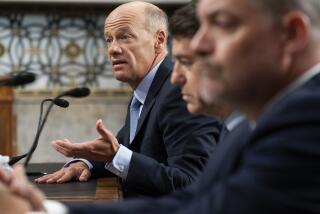Taxpayers Should Not Bear Cost of S&L; Bailout, Banking Experts Say
- Share via
WASHINGTON — Taxpayers must be the “last resort” in meeting the estimated $100-billion cost of bailing out the savings and loan industry’s 350 insolvent institutions, while the government should “look within the industry for all of the financial help you can get,” Senate Banking Committee chairman Donald W. Riegle Jr. (D-Mich.) said Sunday.
Riegle, appearing on ABC’s “This Week with David Brinkley,” gave tentative support to the argument that industry competition will keep savings institutions from passing on any increased deposit insurance fees to consumers. This concept was advanced by another guest on the program, Preston Martin, former vice chairman of the Federal Reserve and an investor in California S&L;’s.
Martin said “there is no way” the increase could be passed along to customers of the institutions.
“The competition for savings in this country, particularly from Wall Street mutual funds, means that you drop your savings rate and the money leaves,” he said. And, he said, competition for mortgage business is stiff enough so that “if you change your mortgage rate, you won’t originate any mortgages.” If there is an increase, he said, “we absorb it ourselves.”
He noted that his group, which controls three S&Ls;, has budgeted $13 million for deposit insurance premiums payable to the Federal Savings and Loan Insurance Corp, but “may have to pay more.”
Pressure on Deposit Rate
U.S. Comptroller Gen. Charles Bowsher, who heads the congressional General Accounting Office, agreed that “there is a lot of pressure on the deposit rate,” but predicted “a big effort” to pass on any increase in deposit insurance fees.
A recommendation that some sort of fee be imposed to help pay $6 billion to $9 billion in interest charges on a bond issue that would finance the rescue of failed S&Ls; is expected to be included in the budget program that President Bush will present to Congress Thursday night.
The concept of an increase in deposit insurance premiums applicable both to S&Ls; and to commercial banks has been vigorously opposed by commercial bankers, who are resisting any plan to merge their insurance plan, administered by the Federal Deposit Insurance Corp., with the bankrupt S&L; insurance fund handled by the Federal Savings and Loan Insurance Corp. The banks pay a premium of 83 cents for each $1,000 of deposits, while the FSLIC rate is $2.10 for each $1,000.
There was no support on the ABC program for the idea, originally floated by the Treasury, of charging depositors 25 cents for every $100 in deposits, which Riegle called “a non-starter.”
But Alan K. Simpson (R-Wyo), the Senate’s minority whip, refused to rule out the deposit fee.
“You’ve got to put all sorts of things on the table,” Simpson said on NBC’s “Meet the Press.”
Riegle argued that an effort should be made to extract as much money as possible from the S&L; industry, especially in cases where funds have been siphoned off through fraud, before the taxpayers are asked to finance a bailout plan.
Bowsher strongly supported this approach, but emphasized that reforms in lending practices should be put in place before taxpayer funds are committed.
Another guest on the ABC show, Edwin Gray, former chairman of the Federal Home Loan Bank Board, said the board had warned Congress “many times” of problems with the S&L; industry, recalling that he told the House Banking Committee in 1984 that “massive infusions” of Treasury funds “may well be necessary to shore up the system.”
Gray said “one of the big reasons” Congress failed to act “was that the powerful thrift lobby, with all of those contributions going to members of Congress, was stopping any action by the Congress to come to grips with it.”
More to Read
Inside the business of entertainment
The Wide Shot brings you news, analysis and insights on everything from streaming wars to production — and what it all means for the future.
You may occasionally receive promotional content from the Los Angeles Times.










